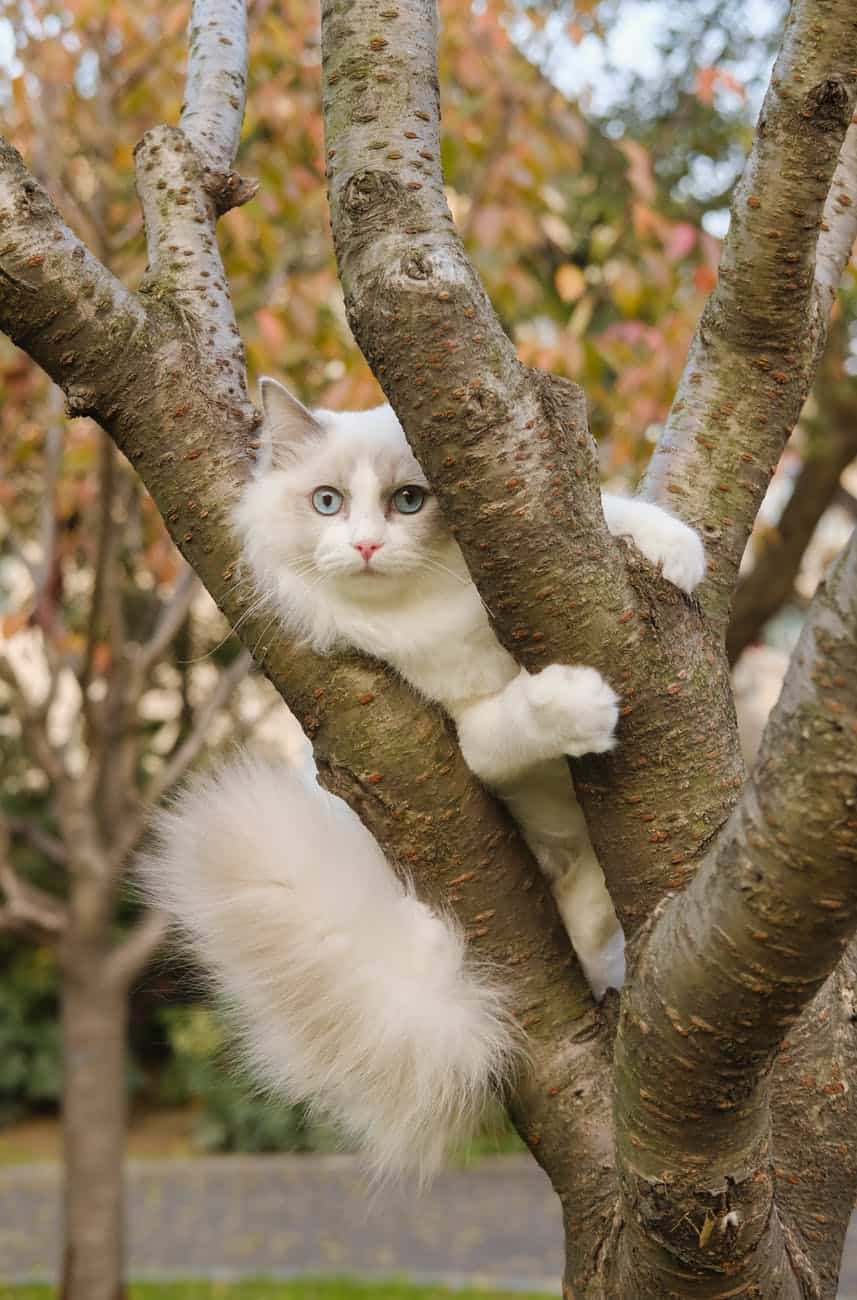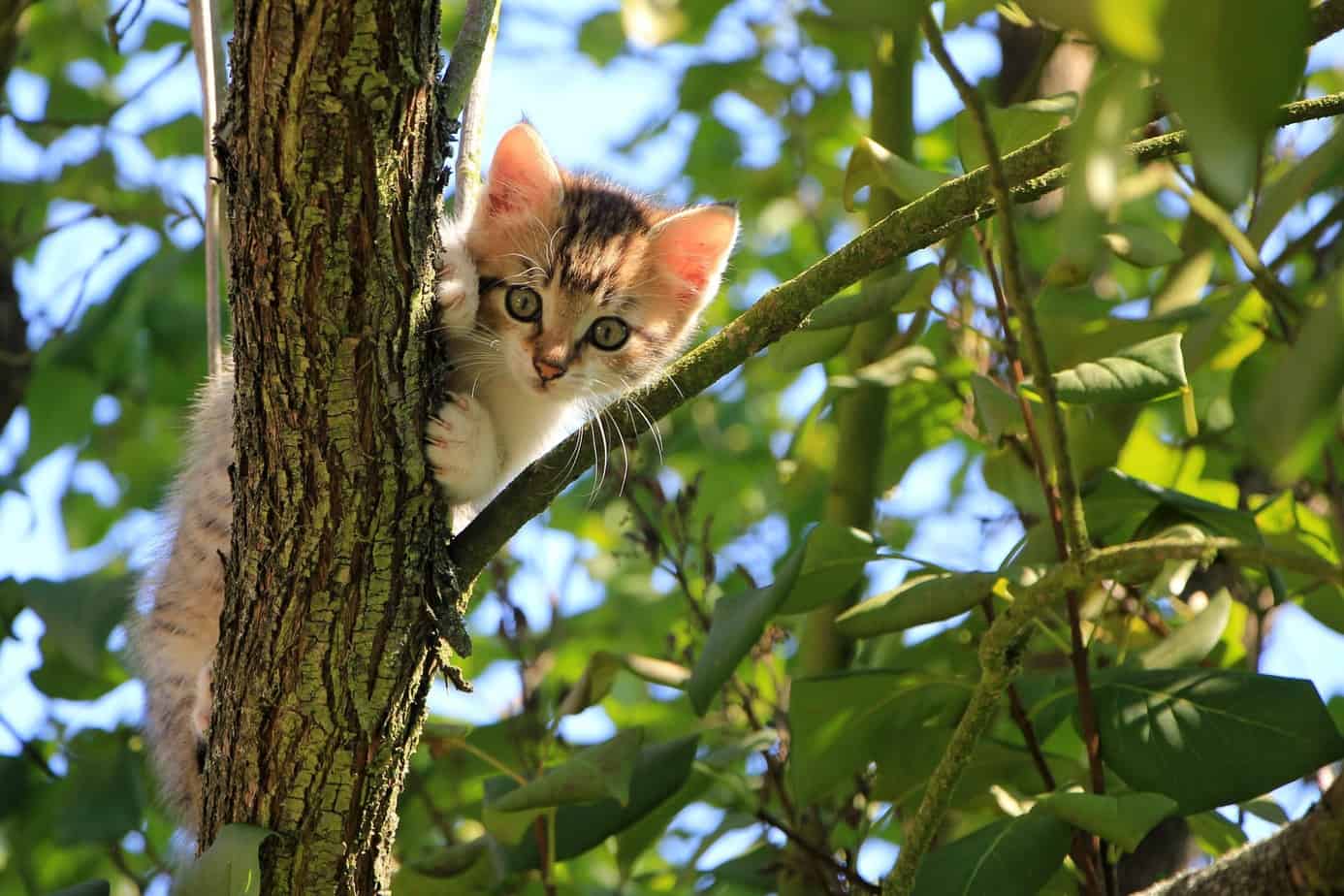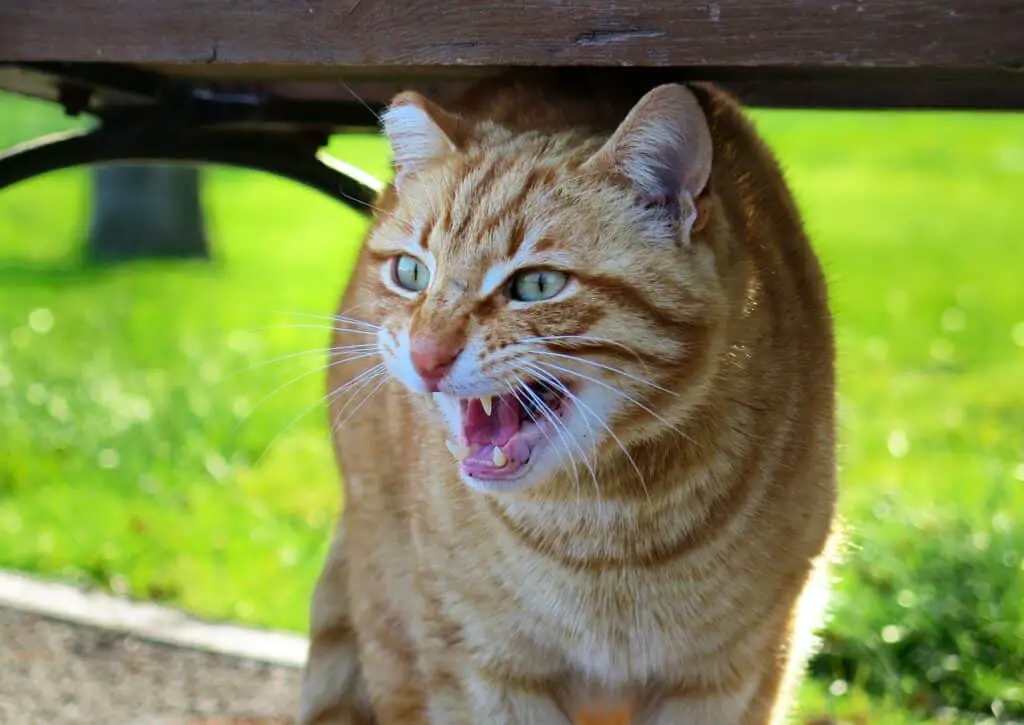Many cat-parents have been in the situation where we found our precious cat-child stuck in a tree. How does this happen, and what can you do to get your cat out of it.
Why do cats get stuck in trees?
Cats get stuck in trees because they can get carried away during the hunt and chase their (fictional) prey into a tree or flee from an attacker. Although cats can climb very well and are not afraid of heights, climbing out of a tree can be a problem because they get scared.
Why are cats afraid to climb down?
A cat’s claws are like little ‘hooks’ that are very good for climbing trees. All they have to do is hook in their nails and pull themselves up.
When it comes to climbing down again, the most logical way would be to descend ‘butt first’ and use their claws as a way to control their descend.
However, most cats don’t understand this and try to get down headfirst. When descending this way, their claws are of no use because the ‘hooks’ point the wrong way. As a result, they cannot keep themselves from slipping and falling because they have no grip.
This is not really a problem for small and low trees because cats will just run down quickly. However, this becomes an issue for taller trees, and the cat gets afraid to lose its grip and fall.
Why do cats climb trees in the first place?
Cats climb in trees for two reasons; either for the hunt, to chase prey, or to flee from something or someone.
As with many animals, when in danger, cats have the instinct to climb up. It’s a bit strange when you think about it because most of a cat’s natural enemies can also climb trees (foxes, raccoons, snakes)
Another reason is for the hunt. The advantage of being able to climb trees and chase potential prey is obvious. Even domesticated cats still do this when chasing rodents or birds. Not because they’re hungry but for the fun of it.
What to do if your cat is stuck in a tree?
There are several things you can do to try and get your cat to come down. Below are some of our favorite tactics.
Don’t Panic
The most important tip we can give is to stay calm and not panic. You’re not going to help anyone and certainly not your cat by panicking.
If you stay calm, so will your cat. This will also increase the odds of getting her down safely.
No crowds
Make sure that there’s no crowd gathering at the base of the tree. A scared cat will prefer to stay up there instead of risking a jump into a crowd of unknown people.
Lure them with food
One of the first things to try is to see if you can lure your cat out with their favorite food. Preferably use a strong-smelling food as this might help persuade them to come down.

Get a ladder
If you’re able and willing to climb after your cat yourself, it’s worth a try. Get a ladder or climb the tree yourself.
Make sure to prepare a bag or container for your cat. Even if you’re able to grab your cat, it’s unlikely that he will stay in your arms on the way down. To make sure both of you get down safely, it’s best to secure your cat in a bag or container.
When attempting this method, make sure safety comes first. You’re no good to anyone, especially not your cat when you’re in the hospital with a broken leg.
Build a ramp
Building a makeshift ramp could help your cat to climb down. This can be as simple as a two-by-four, a PVC pipe, or something of the like.
Even if the ramp is not long enough to reach the full height, your cat could use it as a stepping stone on its way down.
Make sure it’s steady and won’t collapse under your cat’s weight. Although cats are no engineers, they are pretty wary not to step on wobbly and insecure surfaces.
Build a makeshift jumping sheet
You could persuade your cat to jump out of the tree onto a sheet or net to break its fall.
To try this, prepare a bed sheet, net, or sheet of plastic to function as a makeshift jump sheet.
Cats won’t understand that this is to catch them and they won’t voluntarily jump onto it. A little encouragement is needed.
Have someone else climb into the tree. This works best if it’s someone other than the cat’s owners. Because the cat will not risk getting caught by a stranger, she might decide to jump and hope for the best. You’ll be ready with your sheet to catch her and break her fall.
Wait
This one is very counter-intuitive, but sometimes the best solution is to wait.
Once the panic has died down a bit and there are no people around who are frantically trying to get her out, your cat might feel relaxed and secure enough to give it another try herself.
Eventually, your cat will get tired and fall asleep. Although they will fight sleep and delay this as long as possible, a cat falling asleep might just fall out of the tree.
It’s something to avoid because of the risk of injury, but we can expect that they land on their feet; it’s a cat, after all.
Call for help
Finally, if everything else fails, call for help. Nowadays, the fire department in most places is not very eager to help get cats out of trees. The reason for this is that many fire departments are understaffed and overwhelmed with other work. Even if they do come, it might take a long time because humans need priority.
Besides calling on the fire department, you could see if local shelters and cat/animal activists are willing and able to help.
The risk for cats of being stuck in trees
It’s essential for the cat’s safety that we try everything to help a stuck cat out of its predicament.
We all know cats can be very stubborn and very patient. Therefore, it’s not unheard of for cats to stay stuck in trees for days.
This comes with risks.
First of all, cats who cannot run or bring themselves to safety are at risk of predators. If we’re talking about a city cat, that risk is pretty low, but depending on where you live, that might be a real danger.
Cats stuck in trees are easy prey for vultures or birds of prey, snakes, venomous insects, and spiders.
Another risk is dehydration. Cats can go without food for an extended period but are particularly sensitive to dehydration. This might induce kidney failure, which would make them very sick within a few days.
It is essential to help a cat down, their life could depend on it.
How to prevent cats from getting stuck in trees
Prevention is often better than the cure, and it is the same with preventing cats getting stuck in the first place. Here are a few things you could do to avoid having to get busy with ladders and ramps.
Get a leash
If you don’t want to bar your cat from going outside but also want to prevent them from climbing trees, a leash might be an option.
Get one that gives your cat enough freedom to move around. Using a leash that is too short will only stress out your cat and is dangerous at the same time.
Create a controlled space for them to go outside
To prevent your cat from wandering too far and getting themselves into an undesirable situation. you could create a closed-off space outside.
There are a few options to do this. For example, by using a simple net or fence. Or, you could invest in something that’s called a “catio” (see picture)
Clip their nails
The best way to prevent tree climbing while still granting your cat the maximum freedom while outside may be to clip their nails.
Without sharp nails, cats will be unable to climb trees and, as a result, they will not get stuck in them.
Be aware, though, that their nails are also for defending themselves. Taking this away from them might make your cat feel insecure outside and at risk of attack without being able to defend themselves.
Neuter your cat
By neutering your cat, their levels of testosterone will drop, and as a result, their hunter’s instinct will be less pronounced.
This will, in most cases, make cats less adventurous and, therefore, less likely to get stuck in a tree.
Get your cat chipped
This is not so much a prevention, but if your cat gets stuck in a tree and somehow gets out while you’re not around, it will be easy to identify your cat and bring her back to you safely.
Final thoughts
Cats are hunters, and that instinct is still strong despite their kind being domesticated for centuries. Therefore, it is only natural for them to enact the hunt, even if they don’t need to for food.
A result of this is that sometimes they get themselves into a predicament and need our help. Although it might not seem like that, your cat will be very grateful for it.
We hope the tips above were helpful. Feel free to comment below if we missed out on something or if you’d like to share an experience.





